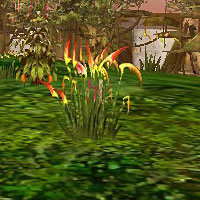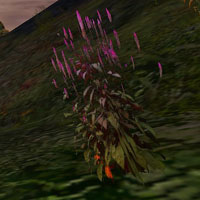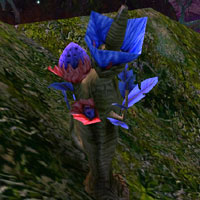discovered by insanity curse
|
Arroyo Plant
Arroyus officinale
Arroyo: 1: a watercourse (as a creek) in an arid region 2: a water-carved gully or channel.
The Arroyo plants grow near creeks or water channels and are a tell-tale sign of a nearby waterway. Ancient villagers used to use crushed leaves to treat sickness in young children, and soldiers during times of war. The villagers would mix the plants with mud and cover themselves in it as a cure-all.
|

|
Blood Fern
Onoclea sanguidae
A tropical cousin to the more common woodland fern species, the Blood Fern is so named for the showy red coloration of its stalks.
This plant was regarded by ancient tonk as a manifestation of the living earth, literally the blood of their ancestors, and a sign that the earth itself is alive in much the way we ourselves are.
|

|
Firethorn
Rubus amargosa
Dense shrub no more than 2 feet tall with cut-outs on the broad dark leaves. Found on semi-bare spongy swamp ground common in the Vesayan region.
The most striking feature of the Firethorn are the spikes of large red-orange thorns which can cause quite a gash to the blundering traveler. The depth of the inflicted wound, paired with the humid bacterial atmospere of Omishan will almost always result in serious infection.
|

|
Mimbu Grass
Strelitzia reginae
This plant forms clumps of long-stalked leaves up to 3 feet long. The evergreen, brownish to green leaves have an oblong shape and leathery texture. Beautiful red, orange, and yellow flowers are produced atop long stalks.
Mimbu grass is so named for its colorful flashy flowers, as well as its tendency to sway back and forth for no apparent reason.
|

|
Pod Tree
Stipes podagra
A tropical plant with a rigid stem, reaching heights of up to 20 feet. Despite the name, this is not a true tree, as it lacks a rigid woody trunk.
The seemingly disheveled appearance of a mature Pod Tree is actually an efficient means of reproduction. The plant matter suspended below the pods catches pollen from other trees. When the pods release their seeds, both seed and pollen fall to the ground together, allowing easy pollination of the seeds.
|

|
Purple Javelin
Lythrum salicaria
Upgright perennial herb 2-4 feet in height with prominent purple flowerstalks. Leaves are dark green and lance-shaped.
Purple Javelin adapts readily to natural and disturbed wetlands, and is capable of invading many wetland types including freshwater wet meadows, tidal and non-tidal marshes, river and stream banks and pond edges.
|

|
Sun Palm
Helianthus zebrina
Semi-upright perenniel 8-15 feet high at maturity. Has a sturdy woody stem and striking broad leaves clustered about an oval-form crown. Leaves are orange to red with yellow edging.
Sun palms can be found on the western peninsula of Omishan, and are thought to have been a cultivated ornamental plant before the devestation.
|

|
Sundrop
Stilla oriens
One of the few spring wildflowers to appear in Omishan. Sundrops are a small (less than 1 foot at maturity) non-spreading herb which bears a great number of bright yellow flowers with scarlet centers. Sundrops may be seen in the Western penninsula of Omishan, throughout the Mayoi portal ring.
Sundrops were viewed by the early tonk as a symbol that the earth on which they grew was wholesome and fertile.
|

|
Vesayan Waterlilly
Nymphaea andreana
Stands 5 feet from stem base to stamen when mature, with a 2-foot bud of pink petals, wound tightly together. Like all members of the waterlily family, most of the plant resides below the surface of the water.
Growing usually in clusters of 5-10 plants, this lovely flower emits a sweet, distinct odor. The red pollen is known to be an especially strong allergen for the Lugian race.
|

|
Wild Red
Submit details about this plant!
|

|
Unidentified
Submit details about this plant!
|

|
Unidentified
Submit details about this plant!
|



 Botany Guides
Botany Guides Kingdom Fungi
Kingdom Fungi
 Eco Alerts
Eco Alerts Fun Facts
Fun Facts Reedshark Hunter
Reedshark Hunter
 Desktop Dereth
Desktop Dereth Archaeology
Archaeology Lithomorphism
Lithomorphism TDC Explorer
TDC Explorer


 Botany Guides
Botany Guides Kingdom Fungi
Kingdom Fungi
 Eco Alerts
Eco Alerts Fun Facts
Fun Facts Reedshark Hunter
Reedshark Hunter
 Desktop Dereth
Desktop Dereth Archaeology
Archaeology Lithomorphism
Lithomorphism TDC Explorer
TDC Explorer